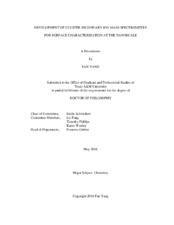| dc.description.abstract | Cluster secondary ion mass spectrometry (SIMS) operated in the event-by-event bombardment-detection mode has been applied to 1) nanodomain analysis of macromolecular brush architecture; 2) characterization of raw and modified plant surfaces; 3) adsorption identification and coverage kinetics of self-assembled monolayer on Au.
When an individual cluster projectile, in the present case Au400^4+ or C60^2+, bombards a surface, it generates secondary ions (SIs) from a spot 10-15 nm in diameter and up to10 nm in depth, i.e. from molecules co-localized within a nanodomain (~10^3 nm^3). Their identification enables, in principle, to analyze surface composition at the nanoscale. Repeating the shot-by-shot bombardment-detection allows probing an ensemble of nanodomains stochastically. One can then extract from the records of individual impacts, subsets of data that correspond to like-domains with sufficient statistics for molecular characterization.
The first type of material investigated was diblock brush terpolymers (DBTs) films. The DBT architecture consists of a rigid backbone linking to side brush chains. A vertically aligned film of DBTs improves the resolution of electron-beam lithography etching to sub-30 nm. Thus, their evaluation and characterization must be performed at the nanoscale. The analysis of mass spectra that are obtained from each nanodomain allows determining the surface coverage by DBTs. The ratio of the surface coverage for the two groups in the DBT, the surface energy reducing moiety and the lithographic functional moiety is a test for vertical alignment. The specimens evaluated showed that the DBT nanodomains are aligned vertically in a homogeneous arrangement.
Au400^4+ cluster SIMS and coincidence counting was also applied to determine the chemical composition and surface homogeneity of plant materials. Co-emitted and correlated SIs show that chemical components (e.g. long chain hydrocarbons, fatty acids, and their derivatives) are not always evenly distributed on the plant surface. The effect of etching with an oxygen plasma on the tomato surface was investigated with the innovative SIMS. The mass spectra results show that the epicuticular wax layer can be removed with a time-dependent oxygen plasma treatment. Further, we could measure the degree of surface coating of polymer (polyethylene glycol or polyvinylpyrrolidone) films physisorbed on the tomato surfaces to keep contents hydrated and prevent the bacterial adhesion. Our observations verified that the polyethylene glycol film could be effectively applied or removed as desired.
C60^2+ SIMS was used to analyze to study the adsorption of self-assembled monolayers (SAMs). Alkanethiol on Au was used as a model SAM. At the level of a single projectile impact, C60 SIMS could characterize the surface homogeneity and coverage of ultra-thin SAMs, a valuable feature for kinetic studies of SAM formation at the nanoscale. | en |


